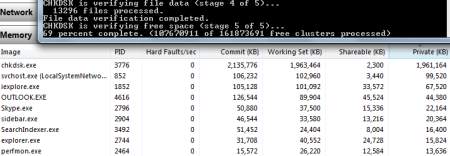Rumors of a ‘massive’ memory leak in Windows 7 appear to have been greatly exaggerated, as Mark Twain might have said.
While some tech sites fell over themselves to smirk at what was billed a ‘show-stopper’ for the new OS appearing on shelves in October, we tried to replicate the fault on two machines and failed to find any problem at all, suggesting that the issue has more to do with chipset issues than the OS itself.
The fault lay with the Chkdsk disk utility which was reported to be gobbling up memory as if there was no tomorrow, eventually resulting in a blue screen of death. Steven Sinofsky, president of Microsoft’s Windows division, said the company was aware of the issue and had explored the problem, but hadn’t been able to reproduce the crashes associated with the flaw in ‘any measurable number’.
Indeed, Microsoft is now advising users to make sure they have the latest drivers installed – which we find it hard to believe that all these “technical experts” had failed to do. Certainly on two Core 2 Duo machines running the 64bit Win7 build 7100 (the RC version) here – a desktop with an Intel 965 chipset and a laptop with an 965 Express, both with 4GB of RAM – we encountered no problems at all.
Chkdsk /r running on a two terabyte secondary (not system) NTFS volume quickly gobbled up 2.1GB of memory, but levelled out there until the utility finished, as illustrated below. In the first screenshot, Chkdsk is 10 percent complete and has processed 4705 files and in the second, taken some time later later, it has munched its way through 107,670,911 clusters. Its memory footprint has actually reduced.


Sinofsky was critical of reports using terms such as “critical” and “show-stopper” to describe the problem, and said there was no reason to delay the shipping of Windows 7: “While we appreciate the drama of ‘critical bug’ and then the pickup of ‘show-stopper’ that I’ve seen, we might take a step back and realise that this might not have that defcon level,” he said.
“Bugs that are so severe as to require immediate patches and attention would have to have no workarounds and would generally be such that a large set of people would run across them in the normal course of using their PC.”
He added that Microsoft would continue to ‘address issues as they arose’, but that this vulnerability ‘was not one of those issues’.






